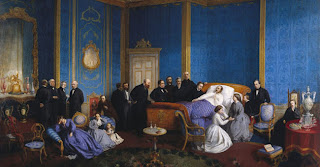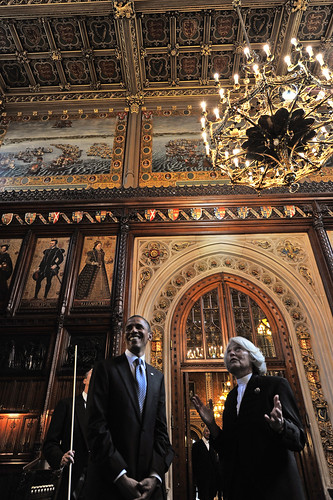At 11pm on 14 December 1861 at Windsor – 150 years ago today – Queen Victoria declared beside the sickbed of the Prince Consort, ‘Oh, yes, this is death!’. Her husband of 21 years, was gone, aged only 42. For many years it was believed that Prince Albert (1819-1861) had died of typhoid, as written on the death certificate by the royal physician, Dr Jenner, but Victoria also believed that her husband had died from overwork and worry occasioned in part by the latest antics of their eldest son, the future Edward VII. However, Albert had been aware of some sinister symptoms – probably stomach cancer – for at least four years before his death, which he kept from the Queen, and it was probably this, combined with pneumonia caused by being caught in a rainstorm returning from a confrontation with the Prince of Wales at Sandhurst, which actually killed him.
 |
| The last moments of HRH the Prince Consort (Wellcome Library) |
Albert’s awareness that something was seriously wrong with him accounts for his manic activity in the years before his death, and one of those activities included the Royal Commission on Fine Arts, a body he had been chairing since its formation in 1841. The Commission was responsible, among other things, for commissioning the fine art and sculpture for the new Palace of Westminster – much to the disgust of Charles Barry, its architect. At the time of Albert’s death, one of its major projects remained unfinished: a replacement scheme for the Armada Tapestries, lost in the 1834 fire.
The intention of the Commission was that six panels in the Prince’s Chamber of the new Palace should contain painted facsimiles of some of the lost tapestries but only one sample had been commissioned by 1861 (by the pre-Raphaelite, Richard Burchett), when Albert died. With his impetus gone, and with the costs associated with building and fitting out the new Houses of Parliament rising alarmingly, the scheme was never finished, and the empty spaces were simply infilled with Pugin wallpaper.
 |
| The Prince’s Chamber, with two of the empty panels visible, wallpapered in red |
Then in 2007, the American philanthropist Mark Pigott donated a sum to the House of Lords Collection Trust, to complete the scheme. As a trustee, and head of the Parliamentary Archives, I was able to visit the artists’ studio set up at Wrest Park, an English Heritage property (one of the few viable places where the creation of the massive canvases was possible) during the creation of the five remaining paintings. It was a fantastic day, with curators, historians, publicists and funders all coming together to see the amazing work in progress led by Anthony Oakshett.
 |
| Monumental painting in progress at Wrest Park |
 |
| Oakshett painting one of the five layers which comprise each artwork |
 |
| Installing the Paintings in the Royal Gallery for temporary viewing, Summer 2010 |
They were then installed high up in the Prince’s Chamber next door where they look as if they they’ve been there ever since Albert’s death, and in final – and fitting – fulfilment of his Commission’s vision.
 |
| President Obama and the Lord Speaker, Baroness Hayman, under the installed Armada Paintings in the Prince’s Chamber, May 2011 (Parliamentary Copyright) |